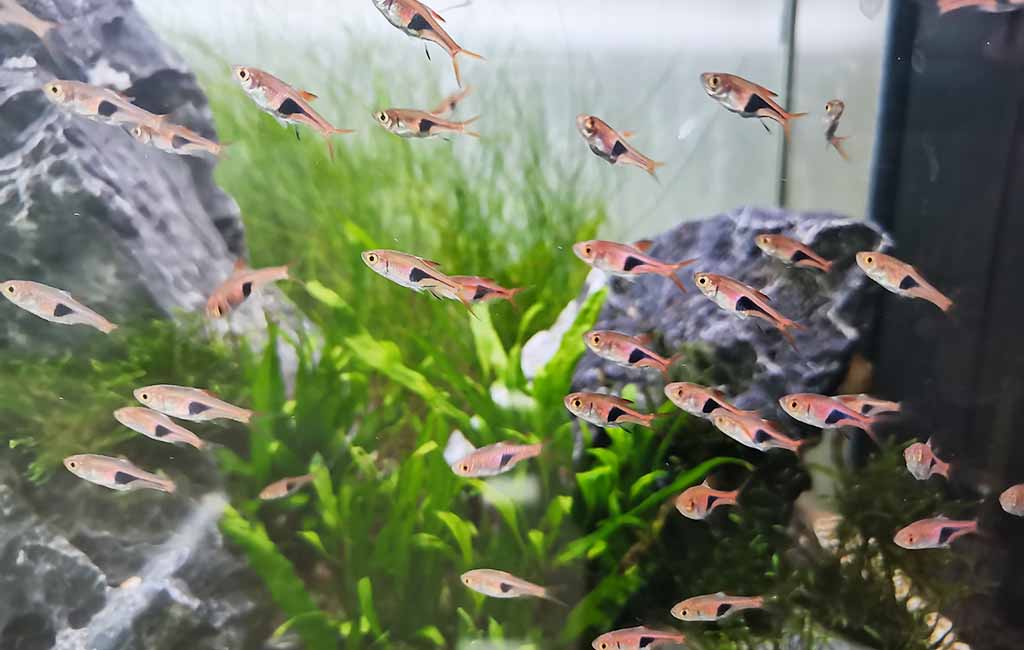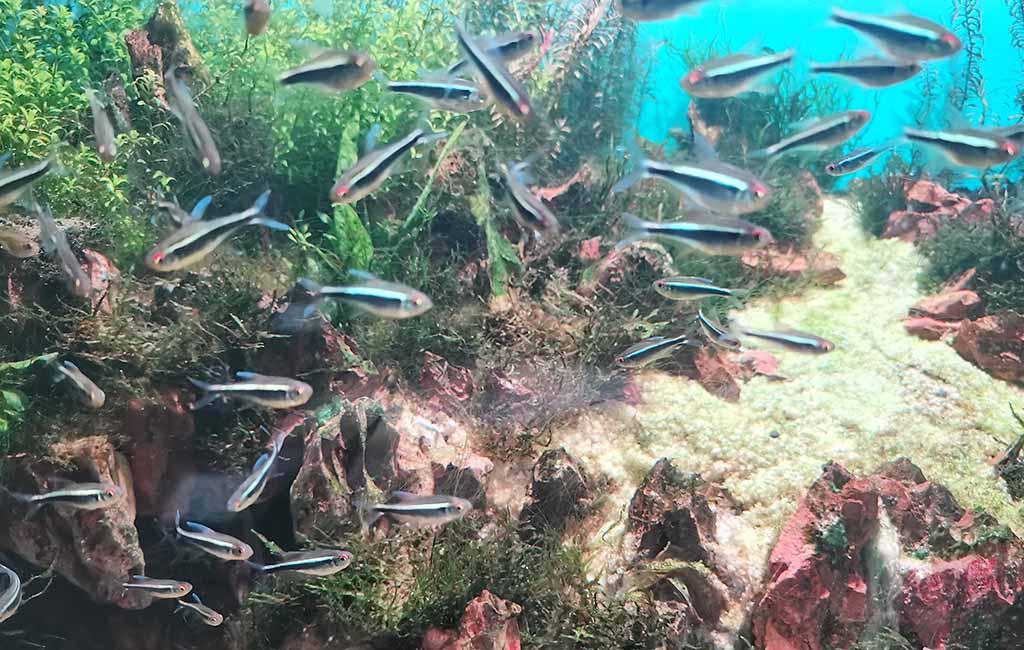Cleaning a fish tank with schooling fish is quite daunting, especially if the tank has not been cleaned for some time. Housing schooling fish like Blackline Tail Tetras, Zebras, or White Cloud Mountain Minnows requires the tanks to be adjusted without stressing the fish or straining the environment.
Content Table
This guide will help relieve such fears, starting with positioning and stabilizing the fish before cleaning and moving on to daily and deep cleaning. You will learn how to clean the schooling fish tank and maintain the tank clean without causing a lot of stress or discomfort to your schooling fish so that they continue to thrive in their environment.

Schooling fish tank
Want to Clean My School Fish Tank
It may be hard to clean a school fish tank that has not been cleaned for years, but if you follow the process outlined here, you will be able to clean it without affecting the lives of the fish. Here’s a step-by-step guide.
Prepare Your Supplies
| Algae scraper or sponge | Gravel vacuum | Bucket for wastewater |
| Water conditioner | Dechlorinated water (ideally with a similar temperature to tank water) | Filter media replacements (if necessary) |
Partial Water Change First
- Replace only 20-30% of the water, as changing the water suddenly will shock the fish, particularly if you are introducing different water types.
- Gently vacuum the gravel to clear it from debris, using a gravel vacuum to prevent disturbing more waste.
Remove Algae and Clean Glass
- However, it is important to clean the algae from the tank glass using an algae scraper or a soft sponge. Remember not to act boldly because schooling fish may get startled.
Clean Decorations Carefully
- Carefully wash off any ornaments with algae bio load and rinse them in tank water in a second bucket. No soap or any form of chemical should be used to help with cleaning, since they are toxic to your fish.
Filter Cleaning
- Rinse the filters in dechlorinated water or water from the tank so that the helpful bacteria will not be killed. Change only the amount of the media that the fish requires to bring the nitrogen cycle back to normal.

Clean schooling fish tank
Top Off With Conditioned Water
- Rinse the water filter with dechlorinated water, which should be as near the temperature of the tank as possible to reduce stress on the fish.
Monitor and Repeat Gradually
- Since the tank has taken a long time to be used without being cleaned, it is recommended that you take the said process over several weeks so that your fish can gradually adapt to the situation and more importantly to ensure that the tank becomes stable.
- The second week requires another partial water change and cleaning up a bit more than in the previous week.
Additional Tips for Managing Schooling Fish
- Keep movements slow to avoid scattering the fish. Schooling fish respond well to calm, steady movements.
- Watch for signs of stress, like gasping at the surface, clamped fins, or erratic swimming, and reduce cleaning intensity if these occur.
How to Arrange for School Fish Before Cleaning the Tank
Daily Maintenance for Schooling Fish Tanks
- Observe Fish Behavior
Check for any changes in fish behavior, signs of stress, or illness. Catching issues early can help you avoid problems during big maintenance.
- Water Quality Testing
Test the water parameters regularly for ammonia, nitrite, nitrate, and pH levels. Stable water quality keeps schooling fish healthy and better prepared for bigger cleanings.
- Small Water Changes
Replace 10-15% of the water weekly to keep the environment fresh without drastic changes that could disturb the schooling fish.
- Surface Cleaning
Use a sponge cleaning kit or algae magnet daily to remove any visible algae from the glass. Doing this regularly prevents buildup and reduces the need for intensive scrubbing later.
- Check Filter Functionality
Ensure your filter is running smoothly. Avoid frequent full cleanings of the tank filter, but rinse or replace the media as necessary in tank water to maintain beneficial bacteria.

how to clean schooling tetra fish tank
Big Maintenance: Prepping for a Thorough Cleaning
- Plan Gradual Cleaning Sessions
Break down big maintenance tasks over several days if the tank is very dirty. Sudden, drastic cleaning can disrupt the fish and beneficial bacteria.
- Separate a Holding Tank if Necessary
For heavy cleanings, set up a temporary holding tank or bucket with clean, dechlorinated water of the same temperature and pH. If your schooling fish seem particularly skittish, this can make things easier.
Add an air stone for oxygenation if they will be in there for a while, and consider adding a few plants or a dark-colored background to help them feel secure.
- Turn Off Tank Lights
Reduce stress by turning off the tank lights before starting big maintenance. Schooling fish feel more secure in dim lighting, which may reduce erratic movements during cleaning.
- Clean in Sections
Clean about a third of the gravel each session rather than doing it all at once. This helps keep beneficial bacteria intact and avoids stirring up too much waste at once.
Use a gravel vacuum gently, moving slowly, so the fish aren’t startled.
- Arrange Plants and Decorations Strategically
Schooling fish appreciate cover, so place plants and decorations in a way that creates areas where they can retreat. These hiding spots will make them feel safe even when you’re moving around the tank.
- Keep the School Together
Avoid removing individual fish if possible. Schooling fish like to stay together and can become stressed if separated. If a holding tank is needed, transfer them as a group.
- Slowly Refill and Condition the Water
After cleaning, refill with dechlorinated water that matches the tank’s temperature to avoid temperature shock. Pour water in slowly, aiming for the sides to minimize water movement.

Schooling fish tank maintenance
Post-Cleaning Routine
- Observe for Stress
After big maintenance, watch for signs of stress (erratic swimming, gasping, hiding). Provide extra cover or dim lighting if the fish seem unsettled.
- Resume Normal Routine Gradually
Resume feeding and turn on lights slowly to help the fish adjust back to normal.
Some Ways to Clean Schooling Fish Tanks Properly
Partial Water Change: Perform about 25-30 percent water change every week to ensure that hazardous compounds are eliminated, and water chemistry is stable. To remove materials from the gravel, use a gravel siphon at the same time when you are siphoning the water.
Clean the Filter: Clean filter media in old tank water monthly but avoid changing filter media in favor of bacteria-friendly bacterial media unless it is dirty. Do not use tap water for this because it’s detrimental to the bacteria you need to use for this purpose.
Scrub Algae on Tank Walls: There are two types of cleaners that you should use to clean the glass of the tank, and they include an algae scrubber or magnetic cleaner. At the same time, algae make the water look uninviting and harm the water in the tray.
Rinse Decorations and Plants: Pop any decorative items and fake plants, and wash them in tank water or water without chlorine. Do not use soap and other chemicals, as the residues are damaging even to living fish.
Monitor and Adjust Temperature and pH: Schooling fish require a particular water temperature that can be checked using a thermometer to avoid going beyond this optimal temperature. Also, perform the pH level test and control the level by using the right products available in the market so that it does not fluctuate.
Use a Gravel Vacuum: A gravel vacuum should be done during partial water changes to avoid the build-up of ammonia from the remains of the food trapped in the substrate.
Add Live Plants: Introducing real plants in the tank eradicates the problem as they compete for space and claim nutrients, hence working to create a healthy world for your schooling fish.
Test Water Regularly: The water should be checked daily, at least, for ammonia, nitrites, nitrates, and the pH level. Siphon the tank straight away if the levels are high or low and since schooling fish are relatively delicate, water quality is paramount.

Cleaning the neon tetra schooling fish tank
Closing Remarks
Indeed, a clean schooling fish tank can be a real challenge, but if properly executed, it does not affect the fish. If you’re stuck on how to clean a schooling tetra fish tank, you should now know that by organizing the complexities of space and the character of the lighting appropriately, one can keep the schooling fish hygienically and healthily throughout the schooling process. Always keep an eye on your fish while cleaning, and if your fish seem stressed out, then you should change your approach. Your schooling fish will do well in their environment provided that you provide them with proper and constant care.


Leave a comment